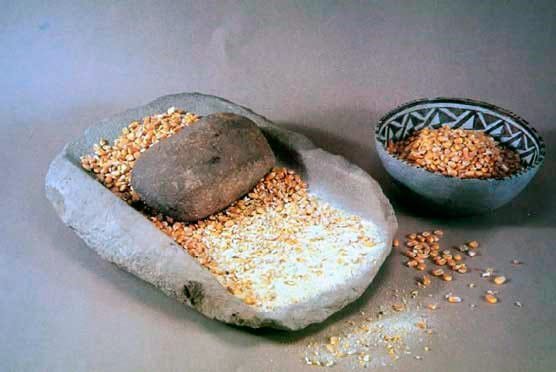Object of the Month
by Amanda Mather
Here at Las Golondrinas where you find early kitchens, you will find a mano and metate. And although mills came to New Mexico with Oñate, many could not afford to get their corn ground, preferred it ground “the old fashioned way” (this is more than likely to have been a Puebloan influence) or lived too far from the mill to make it practical to have it ground at the mill “in town.” And so the mano and metate persisted, for this reason and for others including the exploitation of wild food resources, in both Pueblo and Spanish households.

Different types of rocks are better for grinding different types of foods, so there are different types of manos and metates. Dried grain, primarily corn, was most often ground on vesicular basalt, an igneous rock created through volcanism. As magma rises to the earth’s surface and cools, gas bubbles become trapped creating vesicles or pits in the surface of the basalt. So, this type of lava rock is full of holes. These holes, as it turns out, are extremely useful when grinding a hard grain, such as corn. In the archaeological record of Native and Spanish households, we see this type of rock being used at the advent of Southwestern agriculture for processing grain, particularly corn, from the beginning of the people in the Southwest eating grain right until the present day.
The eating and using of wild plants persisted in Ancesteral Puebloan societies long after their adoption of agriculture. Spanish households also ate and used wild plants. They taste great and you don’t have to bother growing, weeding, or chasing animals off of them. Anyone who has ever enjoyed the adventure of getting sap in their hair while piñon picking knows what I am talking about.
But some of these wild foods had to be processed by grinding, and a mill was simply not a practical way to do that. Foods like amaranth or Indian rice grass are often ground to be eaten, but when processing these foods, a large scale mill would be impractical. So, these foods were processed as they always had been: at home with a mano and metate.
Some of these foods are not of the grain variety, but of the seed variety, such as piñon nuts or sunflower seeds and others are sticky such as cactus fruit or choke cherry. These types of wild plants do not fare well when ground on vesicular basalt. All those little holes that make vesicular basalt so great for grain, make it really awful for sticky or oily foods. So, in both the archaeological record into the modern era, we see metates of a different variety — those made from rocks like sandstone or slate which are smooth. These would have been included in the “tool kit” of manos and metates, and would have more than likely been essential in every Pueblo and Spanish home in Colonial New Mexico.
The Pueblo people encountered by the Spanish had been living in this often resource poor part of the world and making a go of it for 12,000 years! It would only make sense that the resources they used would be adopted by the settlers as a matter of survival. We can see from archaeological evidence that Spanish period households continued to use wild foods that had previously been eaten by Pueblo people and, in turn, needed the tools utilized by Pueblo people to reap their benefit.
Here at El Rancho de las Golondrinas, we have both types of manos and metates. In the Shepard’s Kitchen, we have vesicular basalt manos and metates, and those made with smooth sandstone. In keeping with the age interpretation of the Placita, the Native women working within the household would have employed both types of manos and metates for grinding different types of foods. We also have the smooth sandstone variety at Sierra Village in Grandmother’s house. Grandma would have more than likely been cooking and eating wild foods as well as herbs for medicinal purposes, and would have certainly processed these foods and herbal remedies using a sandstone mano and metate. By this point in history, most, if not all, of the grain that was being eaten by the family in Sierra Village would have been ground commercially at a mill, so vesicular basalt groundstone would have been a less likely tool being used.
